AirmetTango
Forum Supporter
I was in New Jersey for a couple days for work this week and I got out to a 1930s era school for some hunting while I was there. My expectations were fairly low, because, well...it’s an old school  I’m sure it’s been hunted pretty heavily in the past by who knows how many detectorists...including me! I’ve actually hunted the location before with all my previous machines with some limited success.
I’m sure it’s been hunted pretty heavily in the past by who knows how many detectorists...including me! I’ve actually hunted the location before with all my previous machines with some limited success.
For the first portion of the hunt, I ran across several signals that were almost identical...they rang up like Zincolns, except they were coming in too deep. One after another I was finding targets ringing up a fairly solid 20-21 on the VDI, but varying a little higher and lower at times because of shape and depth, which was displaying 8-10 inches. I knew they couldn’t really be Zincolns at that depth...and sure enough, one by one an oblong harmonium/accordion reed came out of each hole from at least 8 inches down. Dug a total of five of them - by the third, I was calling them as soon as I heard them Not sure what was going on that so many were scattered in that school yard - did someone leave a whole accordion out there to rot at some point?? Or do those reeds get changed out individually and tossed??
Not sure what was going on that so many were scattered in that school yard - did someone leave a whole accordion out there to rot at some point?? Or do those reeds get changed out individually and tossed?? 
 Regardless, it’s kind of cool that on clean up, I could see that each reed was labeled with their associated musical note.
Regardless, it’s kind of cool that on clean up, I could see that each reed was labeled with their associated musical note.
In the process of digging those reeds, I was learning how different Southern New Jersey sandy soil was from the sand occasionally found in the NW Ohio area...the first couple inches was a little stiff but easy enough to cut a plug, but the further down I dug, this stuff increasingly took on the characteristics of mostly cured concrete!! The sand was pretty coarse, almost like construction sand, and in some cases seemed like it was well on its way to becoming sandstone! Anyway, all I had with me was my hand digger, so the 8-10” mark was consistently a chore to dig down to. I was constantly concerned I was going to mar a good target, as I often caught myself just scraping my way through the dense, congealed sand. In fact, I abandoned a couple of good sounding targets during the hunt, simply because I reached a point where I couldn’t dig through the hard pack beyond about 6 to 7”.
The first interesting coin also sounded like a Zincoln, and I honestly figured it was another reed. It also showed a bouncy 20-21 VDI with good depth, and digging turned up a crusty 1912 Wheatie - pretty heavily corroded, but the date was still surprisingly easy to see even in the field. It didn’t really clean up well at all at home - it’s hard to tell if maybe the coin was in a fire, or if something about the coarse, chunky sand just allowed significantly more corrosion. Either way, I was pleased to turn up an older Wheat - it gave me hope that silver might still be afoot!
Sure enough, soon after that Wheat, I got the coil over a solid, stop you in your tracks high tone - it was hitting the target hard and the VDI said 27-28, which is almost certainly a dime. Depth indicated maybe 4-6 inches, so I was optimistic but not convinced of silver. Cut a plug, and by 4 inches down I was struggling against that darn sand again! The stuff looks pretty tame in the pictures, but I promise you, it was the worst digging I’ve experienced in a long time! Anyway, before long, it was clear I had missed the target by a little bit - my pinpointer started sounding off on one of the side walls. Being careful, I gradually cleared away some sand along that wall, and I eventually saw a beautiful, shiny reeded rim standing straight up and down on edge in the wall of the hole!
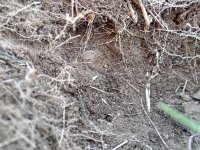
Once I plucked it from the hole, I could see right away that it was a Merc, because the back was perfectly clean. But holy concrete concretions....the front was completely encased in rock solid sand! At first I figured it was just a simple clump that would pop off with my fingernail...nope, it was stuck to the face of the coin like it came that way from the mint. And it was a solid mass, like sandstone...never saw anything like it!
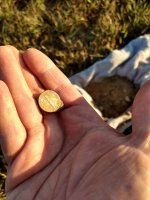
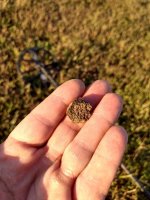
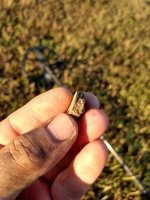
A short while later, I got over another nice sounding high tone...this one was deeper and jumpier, but stayed consistently between 26-30 except for a couple momentary dips to 20 as I spent way too long over-analyzing the signal. Scraping my way through the cursed sand after popping a 3 inch deep plug, I eventually dredged out a sand clump that, according to my pinpointer, had the target entombed inside. As soon as the clump hit my dirt towel, it broke open and disintegrated enough for a second shiny to roll out...another Merc (1940), and this one was almost perfectly clean! And my first double silver hunt since early June!
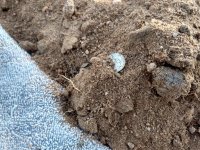
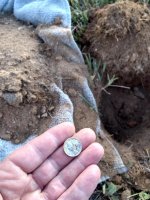
Along the way during the hunt, I found a few bullet casings with some age on them - a couple W.R.A. Co and a UMC. The UMC must date to pre-1914, when they merged with Remington. Also hit on an old saddle rivet, and a small religious pin marked “souvenir first holy communion” on the back - research on the web says it probably dates to the 1940s.
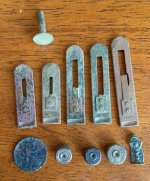
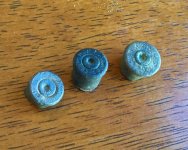
I did eventually got the encrusted 1945 Merc clean - I spent most of the evening after the hunt scratching away at the sandstone concretion with my thumbnail while holding it in a little vat of water. At times I even had to grind at it with the metal file from my leatherman multi-tool! It took a couple hours, and I completely destroyed my thumbnail in the process, but I eventually got it looking like this:
It took a couple hours, and I completely destroyed my thumbnail in the process, but I eventually got it looking like this:
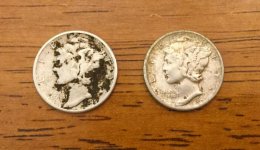
Once I got home to Ohio, I was able to get the final stubborn concretions off using a stiff toothbrush and moist baking soda. Doesn’t look too bad considering!
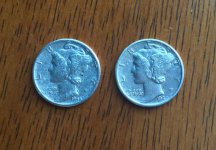
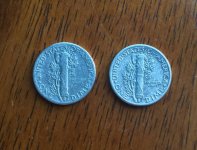
 I’m sure it’s been hunted pretty heavily in the past by who knows how many detectorists...including me! I’ve actually hunted the location before with all my previous machines with some limited success.
I’m sure it’s been hunted pretty heavily in the past by who knows how many detectorists...including me! I’ve actually hunted the location before with all my previous machines with some limited success. For the first portion of the hunt, I ran across several signals that were almost identical...they rang up like Zincolns, except they were coming in too deep. One after another I was finding targets ringing up a fairly solid 20-21 on the VDI, but varying a little higher and lower at times because of shape and depth, which was displaying 8-10 inches. I knew they couldn’t really be Zincolns at that depth...and sure enough, one by one an oblong harmonium/accordion reed came out of each hole from at least 8 inches down. Dug a total of five of them - by the third, I was calling them as soon as I heard them
 Not sure what was going on that so many were scattered in that school yard - did someone leave a whole accordion out there to rot at some point?? Or do those reeds get changed out individually and tossed??
Not sure what was going on that so many were scattered in that school yard - did someone leave a whole accordion out there to rot at some point?? Or do those reeds get changed out individually and tossed?? 
 Regardless, it’s kind of cool that on clean up, I could see that each reed was labeled with their associated musical note.
Regardless, it’s kind of cool that on clean up, I could see that each reed was labeled with their associated musical note.In the process of digging those reeds, I was learning how different Southern New Jersey sandy soil was from the sand occasionally found in the NW Ohio area...the first couple inches was a little stiff but easy enough to cut a plug, but the further down I dug, this stuff increasingly took on the characteristics of mostly cured concrete!! The sand was pretty coarse, almost like construction sand, and in some cases seemed like it was well on its way to becoming sandstone! Anyway, all I had with me was my hand digger, so the 8-10” mark was consistently a chore to dig down to. I was constantly concerned I was going to mar a good target, as I often caught myself just scraping my way through the dense, congealed sand. In fact, I abandoned a couple of good sounding targets during the hunt, simply because I reached a point where I couldn’t dig through the hard pack beyond about 6 to 7”.
The first interesting coin also sounded like a Zincoln, and I honestly figured it was another reed. It also showed a bouncy 20-21 VDI with good depth, and digging turned up a crusty 1912 Wheatie - pretty heavily corroded, but the date was still surprisingly easy to see even in the field. It didn’t really clean up well at all at home - it’s hard to tell if maybe the coin was in a fire, or if something about the coarse, chunky sand just allowed significantly more corrosion. Either way, I was pleased to turn up an older Wheat - it gave me hope that silver might still be afoot!
Sure enough, soon after that Wheat, I got the coil over a solid, stop you in your tracks high tone - it was hitting the target hard and the VDI said 27-28, which is almost certainly a dime. Depth indicated maybe 4-6 inches, so I was optimistic but not convinced of silver. Cut a plug, and by 4 inches down I was struggling against that darn sand again! The stuff looks pretty tame in the pictures, but I promise you, it was the worst digging I’ve experienced in a long time! Anyway, before long, it was clear I had missed the target by a little bit - my pinpointer started sounding off on one of the side walls. Being careful, I gradually cleared away some sand along that wall, and I eventually saw a beautiful, shiny reeded rim standing straight up and down on edge in the wall of the hole!


Once I plucked it from the hole, I could see right away that it was a Merc, because the back was perfectly clean. But holy concrete concretions....the front was completely encased in rock solid sand! At first I figured it was just a simple clump that would pop off with my fingernail...nope, it was stuck to the face of the coin like it came that way from the mint. And it was a solid mass, like sandstone...never saw anything like it!



A short while later, I got over another nice sounding high tone...this one was deeper and jumpier, but stayed consistently between 26-30 except for a couple momentary dips to 20 as I spent way too long over-analyzing the signal. Scraping my way through the cursed sand after popping a 3 inch deep plug, I eventually dredged out a sand clump that, according to my pinpointer, had the target entombed inside. As soon as the clump hit my dirt towel, it broke open and disintegrated enough for a second shiny to roll out...another Merc (1940), and this one was almost perfectly clean! And my first double silver hunt since early June!


Along the way during the hunt, I found a few bullet casings with some age on them - a couple W.R.A. Co and a UMC. The UMC must date to pre-1914, when they merged with Remington. Also hit on an old saddle rivet, and a small religious pin marked “souvenir first holy communion” on the back - research on the web says it probably dates to the 1940s.


I did eventually got the encrusted 1945 Merc clean - I spent most of the evening after the hunt scratching away at the sandstone concretion with my thumbnail while holding it in a little vat of water. At times I even had to grind at it with the metal file from my leatherman multi-tool!
 It took a couple hours, and I completely destroyed my thumbnail in the process, but I eventually got it looking like this:
It took a couple hours, and I completely destroyed my thumbnail in the process, but I eventually got it looking like this:
Once I got home to Ohio, I was able to get the final stubborn concretions off using a stiff toothbrush and moist baking soda. Doesn’t look too bad considering!




 . But in all sincerity it looks like you had a good time. It would be nice to travel elsewhere to detect from time to time. Your job gives you that opportunity. Good job on adding a few more silver to your count this year.
. But in all sincerity it looks like you had a good time. It would be nice to travel elsewhere to detect from time to time. Your job gives you that opportunity. Good job on adding a few more silver to your count this year.